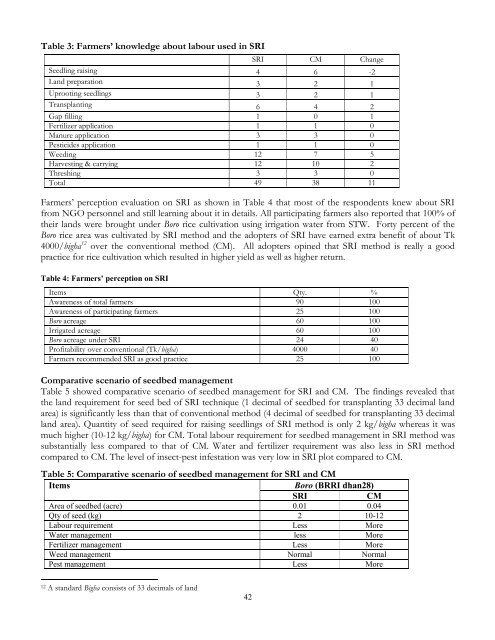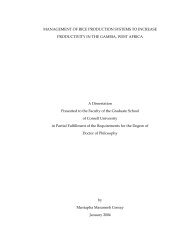Revised proceedings - The System of Rice Intensification - Cornell ...
Revised proceedings - The System of Rice Intensification - Cornell ...
Revised proceedings - The System of Rice Intensification - Cornell ...
You also want an ePaper? Increase the reach of your titles
YUMPU automatically turns print PDFs into web optimized ePapers that Google loves.
Table 3: Farmers’ knowledge about labour used in SRI<br />
42<br />
SRI CM Change<br />
Seedling raising 4 6 -2<br />
Land preparation 3 2 1<br />
Uprooting seedlings 3 2 1<br />
Transplanting 6 4 2<br />
Gap filling 1 0 1<br />
Fertilizer application 1 1 0<br />
Manure application 3 3 0<br />
Pesticides application 1 1 0<br />
Weeding 12 7 5<br />
Harvesting & carrying 12 10 2<br />
Threshing 3 3 0<br />
Total 49 38 11<br />
Farmers‟ perception evaluation on SRI as shown in Table 4 that most <strong>of</strong> the respondents knew about SRI<br />
from NGO personnel and still learning about it in details. All participating farmers also reported that 100% <strong>of</strong><br />
their lands were brought under Boro rice cultivation using irrigation water from STW. Forty percent <strong>of</strong> the<br />
Boro rice area was cultivated by SRI method and the adopters <strong>of</strong> SRI have earned extra benefit <strong>of</strong> about Tk<br />
4000/bigha 12 over the conventional method (CM). All adopters opined that SRI method is really a good<br />
practice for rice cultivation which resulted in higher yield as well as higher return.<br />
Table 4: Farmers’ perception on SRI<br />
Items Qty. %<br />
Awareness <strong>of</strong> total farmers 90 100<br />
Awareness <strong>of</strong> participating farmers 25 100<br />
Boro acreage 60 100<br />
Irrigated acreage 60 100<br />
Boro acreage under SRI 24 40<br />
Pr<strong>of</strong>itability over conventional (Tk/bigha) 4000 40<br />
Farmers recommended SRI as good practice 25 100<br />
Comparative scenario <strong>of</strong> seedbed management<br />
Table 5 showed comparative scenario <strong>of</strong> seedbed management for SRI and CM. <strong>The</strong> findings revealed that<br />
the land requirement for seed bed <strong>of</strong> SRI technique (1 decimal <strong>of</strong> seedbed for transplanting 33 decimal land<br />
area) is significantly less than that <strong>of</strong> conventional method (4 decimal <strong>of</strong> seedbed for transplanting 33 decimal<br />
land area). Quantity <strong>of</strong> seed required for raising seedlings <strong>of</strong> SRI method is only 2 kg/bigha whereas it was<br />
much higher (10-12 kg/bigha) for CM. Total labour requirement for seedbed management in SRI method was<br />
substantially less compared to that <strong>of</strong> CM. Water and fertilizer requirement was also less in SRI method<br />
compared to CM. <strong>The</strong> level <strong>of</strong> insect-pest infestation was very low in SRI plot compared to CM.<br />
Table 5: Comparative scenario <strong>of</strong> seedbed management for SRI and CM<br />
Items Boro (BRRI dhan28)<br />
SRI CM<br />
Area <strong>of</strong> seedbed (acre) 0.01 0.04<br />
Qty <strong>of</strong> seed (kg) 2 10-12<br />
Labour requirement Less More<br />
Water management less More<br />
Fertilizer management Less More<br />
Weed management Normal Normal<br />
Pest management Less More<br />
12 A standard Bigha consists <strong>of</strong> 33 decimals <strong>of</strong> land

















